Prior to the establishment of hospitals, medical treatment on the gold fields of Ballarat and Mount Alexander was rudimentary. Doctors – many of whom were untrained – or quack physicians, tended to the medical needs of the community. A tent, with a flag bearing a snake encircling a sword, served as a surgery, with a sign outside advertising ‘Dr ___’. In 1853, some 22 qualified doctors and countless more medical charlatans resided within a population of 15,000 at Mount Alexander. Sometimes, patients travelled to Melbourne or other large centres for hospital treatment, a costly process that required travel on difficult roads, far from family and friends. Local newspapers advertised hospitals near Melbourne where diggers could convalesce or seek medical treatment. An advertisement in the Ballarat Times in September 1855, advised that ‘sick miners will find a comfortable home, advice and a good nursing, at Dr Brownless’ Medical Hospital, near Melbourne. Full particulars may be obtained at the Times Office, Ballarat.’
As the diggings swelled with an increasingly permanent population, the establishment of hospitals became a more pressing issue. The increase in mining and travel accidents, fires, and illness and disease, called for more advanced medical treatment and better facilities. The cramped and unhygienic living conditions, together with poor water and inadequate diet, meant illness and disease – especially dysentery – were commonplace. After suffering a bout of the intestinal infection, one miner wrote: ‘I rose from this sickness after many weeks, the shadow of my former self, hair fallen out, teeth loosened and a figure shrunken and bent with weakness.’
In February 1853, a meeting was held at Mount Alexander to establish a hospital for the local community. Three months later, a small wooden hospital was opened in Gingell Street comprising of a central ward (measuring thirty feet by twenty feet) with secondary rooms leading off it. In 1868, the hospital was demolished and a more substantial two-storey brick building was constructed on the site.
Following the Eureka uprising, the appalling state of Ballarat’s basic medical facilities became evident, and a meeting was soon held to raise money to build the town’s first hospital. The unrest highlighted the town’s inadequate medical capabilities, as there were simply not enough resources to treat all the wounded. A joint venture between the government and local residents, the hospital was constructed; its foundation stone was laid on Christmas Day, 1855, on the site of the present hospital. Opening in 1856, the medical institution was known for many years as the Miners’ Hospital and provided free medical treatment that was funded through voluntary subscriptions and government grants.




